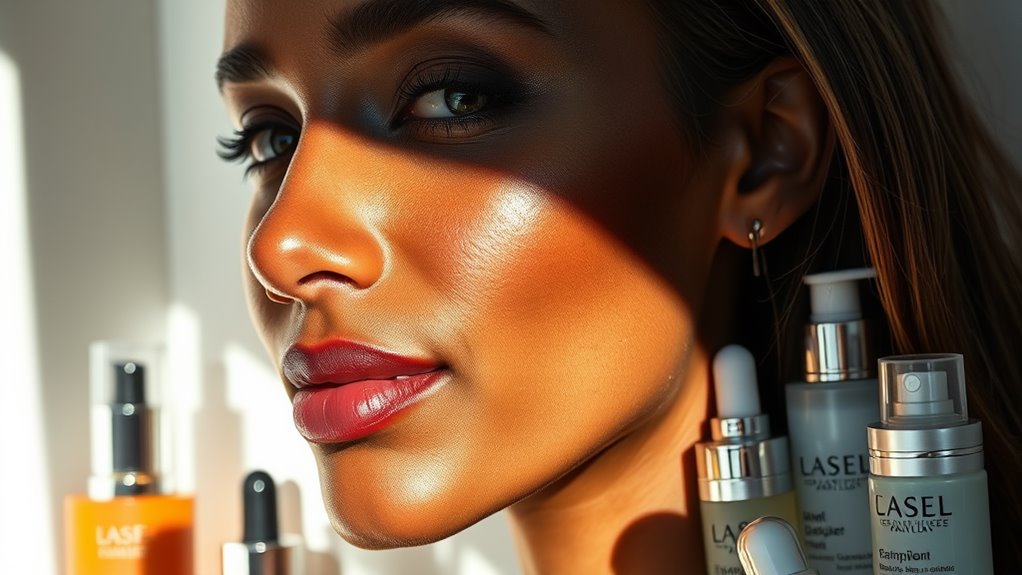Hyperpigmentation Explained- What Works and What’s Just a Waste of Money
Hyperpigmentation can be frustrating, especially when you’re trying to find effective solutions. You might feel overwhelmed by the countless products and treatments claiming to lighten dark spots. It’s essential to distinguish between what truly works and what’s just a waste of money. Understanding the underlying causes and effective methods can make a significant difference in your skincare journey. So, what should you really focus on to achieve lasting results?
Understanding Hyperpigmentation: Causes and Types
Hyperpigmentation occurs when certain areas of your skin produce excess melanin, leading to dark patches that can affect anyone, regardless of skin type.
It’s important to understand that various factors contribute to this condition. Sun exposure, hormonal changes, and skin injuries can all trigger increased melanin production.
You’ll find different types of hyperpigmentation, such as sunspots, melasma, and post-inflammatory hyperpigmentation. Each requires a tailored approach to hyperpigmentation treatment, emphasizing the need for personalized solutions.
Effective Treatments for Hyperpigmentation
Finding an effective treatment for hyperpigmentation can feel overwhelming, but you have several options that can help restore your skin’s natural tone.
Start with topical treatments containing ingredients like hydroquinone, azelaic acid, or vitamin C, which brighten and even out skin tone.
Chemical peels and laser therapies can also make a significant difference, promoting skin renewal and targeting dark spots.
Additionally, don’t forget the power of sunscreen; protecting your skin from UV rays prevents further darkening.
Popular Myths About Hyperpigmentation Remedies
Many misconceptions surround hyperpigmentation remedies, leading to confusion about effective treatments.
You might hear that certain home remedies, like lemon juice or baking soda, can magically erase dark spots. While these are popular, they often do more harm than good, causing irritation instead of improvement.
Another myth is that all sunscreens are the same; in reality, broad-spectrum protection is crucial.
You may also think that hyperpigmentation only affects certain skin types, but it can impact anyone.
Educating yourself about these myths helps you make informed choices and empowers you to embrace your unique skin journey with confidence.
Costly Mistakes: Treatments That Don’t Work
Have you ever wondered why some treatments for hyperpigmentation leave you feeling frustrated and out of pocket? You’re not alone; many of us have chased after quick fixes that promise miracles.
Over-the-counter products packed with harsh chemicals often do more harm than good, irritating your skin instead of helping it. Prescription treatments can also fall short, especially if they don’t suit your unique skin type.
Even trendy treatments like laser therapy may not always deliver lasting results. It’s easy to feel lost in the sea of options, but recognizing these costly mistakes can help you steer clear of disappointment.
Long-term Strategies for Managing Hyperpigmentation
While navigating the world of hyperpigmentation treatments can be overwhelming, adopting long-term strategies can lead to more effective and sustainable results.
Start by incorporating sun protection into your daily routine; wearing sunscreen isn’t just a summer move.
Next, embrace a consistent skincare regimen that includes gentle exfoliation and products with ingredients like vitamin C and niacinamide.
Remember, patience is key—visible improvements take time.
Don’t hesitate to connect with a dermatologist for personalized advice.
Surround yourself with supportive friends or online communities who share similar skin journeys.
Together, you’ll learn, grow, and celebrate every step toward healthier, more radiant skin.





